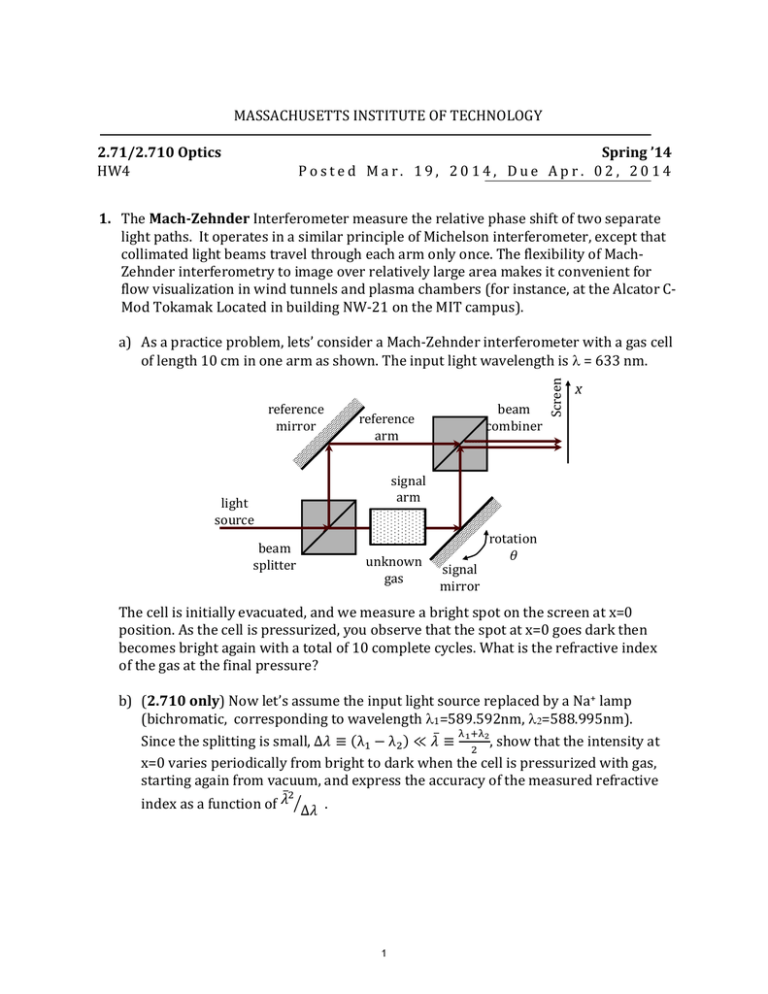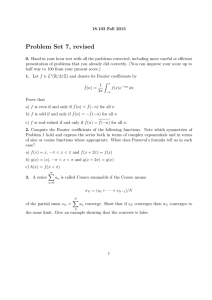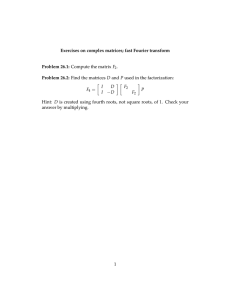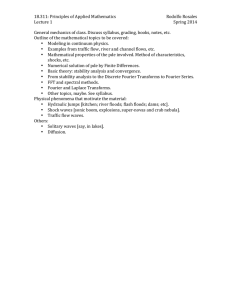
MASSACHUSETTS INSTITUTE OF TECHNOLOGY
2.71/2.710 Optics
HW4
Spring ’14
Posted Mar. 19, 2014, Due Apr. 02, 2014
1. The Mach-Zehnder Interferometer measure the relative phase shift of two separate
light paths. It operates in a similar principle of Michelson interferometer, except that
collimated light beams travel through each arm only once. The flexibility of MachZehnder interferometry to image over relatively large area makes it convenient for
flow visualization in wind tunnels and plasma chambers (for instance, at the Alcator CMod Tokamak Located in building NW-21 on the MIT campus).
reference
mirror
x
signal
arm
light
source
beam
splitter
beam
combiner
reference
arm
Screen
a) As a practice problem, lets’ consider a Mach-Zehnder interferometer with a gas cell
of length 10 cm in one arm as shown. The input light wavelength is = 633 nm.
unknown
gas
signal
mirror
rotation
θ
The cell is initially evacuated, and we measure a bright spot on the screen at x=0
position. As the cell is pressurized, you observe that the spot at x=0 goes dark then
becomes bright again with a total of 10 complete cycles. What is the refractive index
of the gas at the final pressure?
b) (2.710 only) Now let’s assume the input light source replaced by a Na+ lamp
(bichromatic, corresponding to wavelength 1=589.592nm, =588.995nm).
λ +λ
Since the splitting is small, ∆𝜆 ≡ (λ1 − λ2 ) ≪ 𝜆̅ ≡ 1 2 2, show that the intensity at
x=0 varies periodically from bright to dark when the cell is pressurized with gas,
starting again from vacuum, and express the accuracy of the measured refractive
2
̅
index as a function of 𝜆 ⁄∆𝜆 .
1
2. (Pedrotti 8-12) White light is passed through a Fabry-Perot interferometer in the
arrangement shown as follows, where the detector is a spectroscope. A series of bright
bands appear. When mercury light is simultaneously admitted into the spectroscope
slit, 150 of the bright bands are seen to fall between the violet and green lines of
mercury at 435.8nm and 546.1nm, respectively. What is the thickness d of the FabryPerot cavity(etalon)?
© Pearson Prentice Hall. All rights reserved. This content is excluded from our
Creative Commons license. For more information, see http://ocw.mit.edu/fairuse.
3. Exercise on Fourier Transforms: Using known transform pairs and theorems, find the
Fourier transforms of the following:
𝑥
𝑦
a) rect (2𝑊) rect (2𝑊)
b) 𝑒𝑥𝑝 (−
c) circ (
𝑥 2 +𝑦 2
2𝑊 2
√𝑥 2 +𝑦2
𝑊
)
)
𝑥
𝑦
d) sinc(𝑥)comb(𝑦) ⊗ 𝑐𝑜𝑚𝑏(2)𝑠𝑖𝑛𝑐 ( 4)
e) 𝑐𝑖𝑟𝑐(√(𝑥 − 𝑎)2 + 𝑦 2 ) + 𝑐𝑖𝑟𝑐(√(𝑥 + 𝑎)2 + 𝑦 2 )
2
4. Fast Fourier Transform with MIT Seal! Please download an MIT seal (similar to the
attached example), convert it to grayscale by using one of R, G, B color value at each
pixel, and crop its central portion g(x, y) so that it have square shape (e.g., 400 × 400.)
(Please read Voelz Chapter 2 and 3 regarding digital signal processing and FFT with
MATLAB).
a) Plot your image next to the amplitude |𝐺(𝑢, 𝑣)| and phase 𝑎𝑟𝑔(𝐺(𝑢, 𝑣)) of its
Fourier transform 𝐺(𝑢, 𝑣). (more details may be visible if instead you plot
𝑙𝑜𝑔10 |𝐺(𝑢, 𝑣)|.)
b) Amplitude or Phase? Let’s assume one of the above two Fourier spectrum is
immersed in the noise, so we can only recover amplitude or phase information,
while the other is a constant(say |𝐺(𝑢, 𝑣)|becomes 1 everywhere). Please plot the
recovered image based only on |𝐺(𝑢, 𝑣)|or 𝑎𝑟𝑔(𝐺(𝑢, 𝑣)). Which one is closer to the
original barcode?
c) To add a filter to this image, we define a 5 × 5 square region S around the origin of
the (“shifted” in FFT case) Fourier transform domain:
T(u,v)=1 inside S
T(u,v)=0 outside S
Now plot the filtered image: 𝑔1(𝑥, 𝑦) = ∬ 𝐺(𝑢, 𝑣)𝑇(𝑢, 𝑣) exp(−𝑖𝑢𝑥) exp(−𝑖𝑣𝑦)𝑑𝑢𝑑𝑣
d) Now invert the filter, so
H(u,v)=0 inside S
H(u,v)=1 outside S.
Plot the filtered image 𝑔2(𝑥, 𝑦) = ∬ 𝐺(𝑢, 𝑣)𝐻(𝑢, 𝑣) exp(−𝑖𝑢𝑥) exp(−𝑖𝑣𝑦)𝑑𝑢𝑑𝑣.
3
If you use MATLAB to solve this problem, you will find the following functions useful:
(i) fft2 computes the 2D Fourier transform of an image and returns it with some
quadrants swapped, (ii) fftshift rearranges the quadrants of the Fourier transform in
their proper order, (iii) ifft2 computes the inverse 2D Fourier transform (iv) imagesc;
colormap gray displays a real grayscale image, (v) print -dps [filename] prints a figure
into a postscript file which you can then print at any Athena printer using the lpr
command.
This course makes use of Athena, MIT's UNIX-based computing environment. OCW does not provide access to this environment.
4
MIT OpenCourseWare
http://ocw.mit.edu
2.71 / 2.710 Optics
Spring 2014
For information about citing these materials or our Terms of Use, visit: http://ocw.mit.edu/terms.




